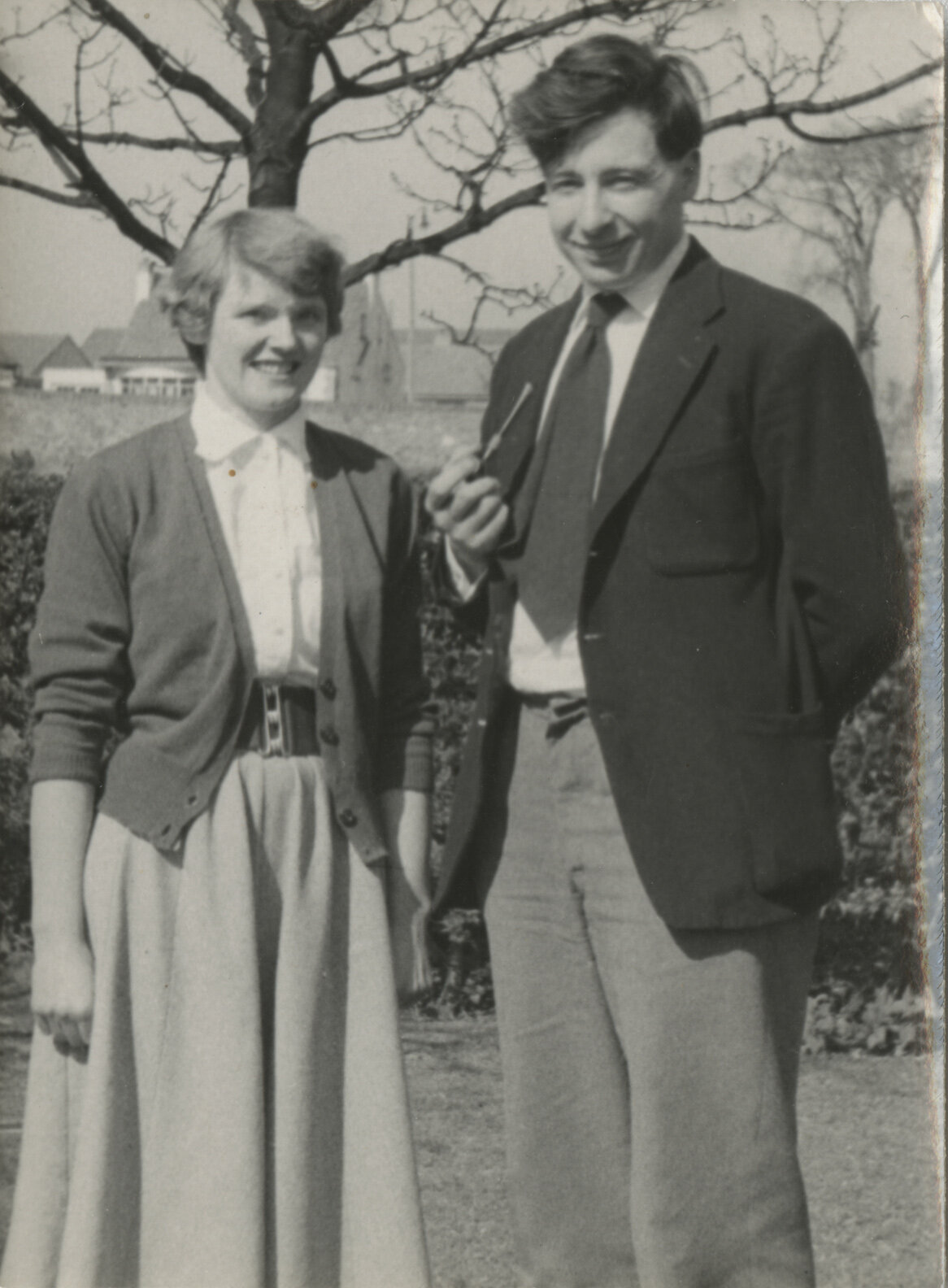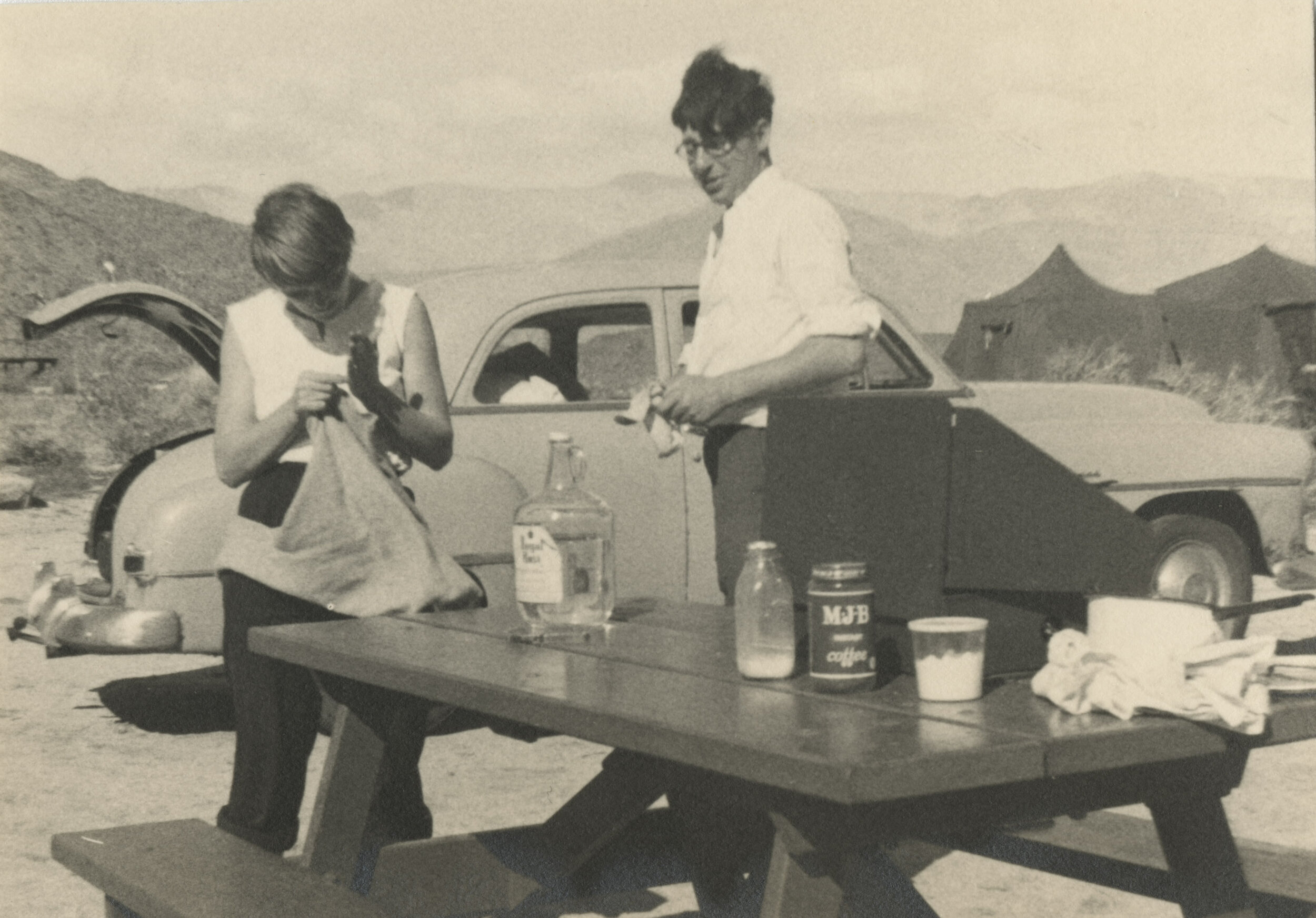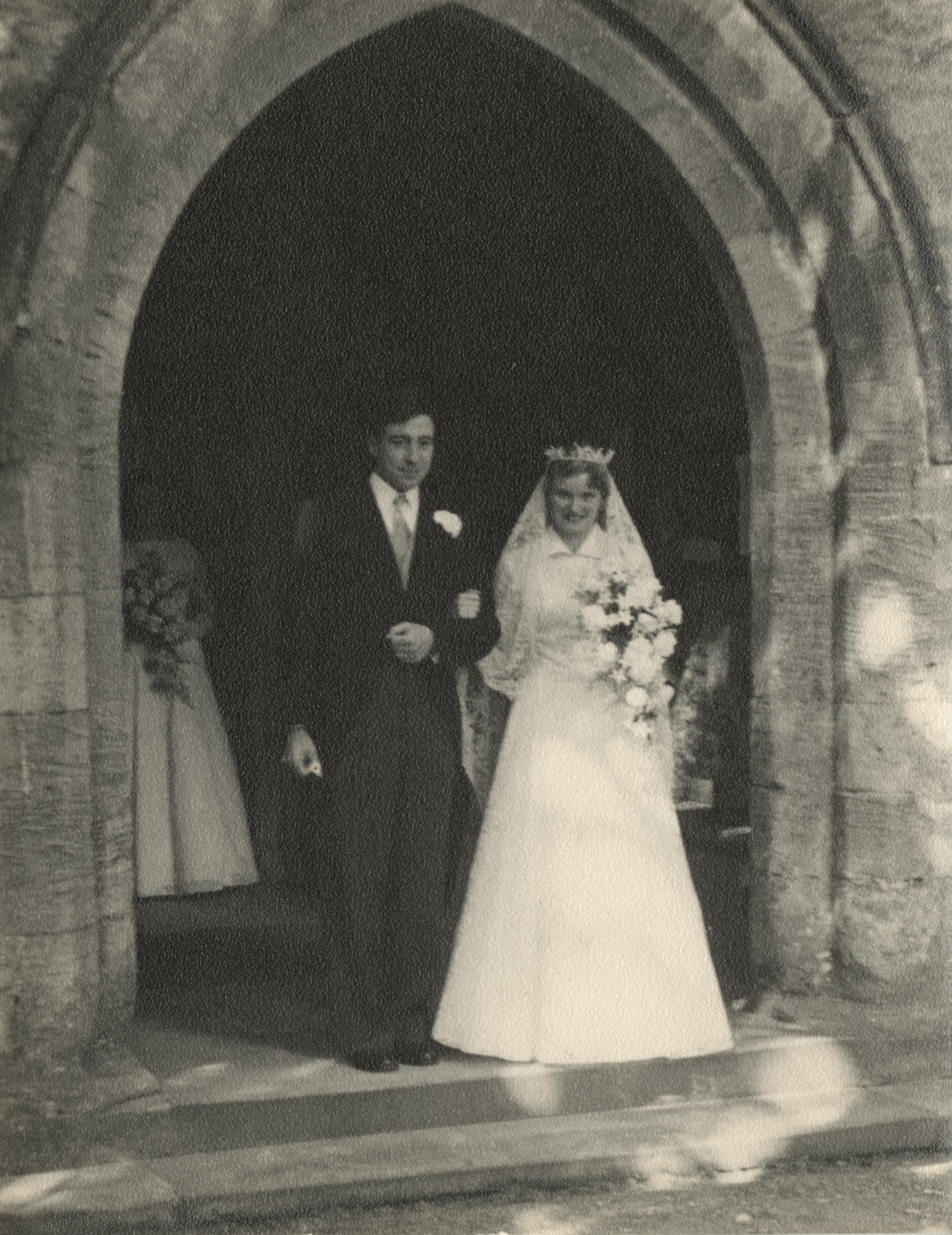The Archive of Robert Edwards (IVF pioneer)
The archive of Professor Sir Robert Edwards (IVF pioneer) opened for research in 2019.
The cataloguing and conservation of the papers was generously funded by the Wellcome Trust and Churchill Archives Centre is grateful for their support.
The Edwards papers were deposited at Churchill Archives Centre in 12 separate lots between 2010 and 2018. Most of the papers came from Edwards’ family home and from Bourn Hall (the IVF clinic he established).
In this exhibition we have picked out some themes and aspects of Robert Edwards’ life and work which are evidenced in the archive.

Bourn Hall, c.1979 EDWS 18/8/4
Early professional life and meeting Ruth Fowler (later Edwards)
Following his degree at Bangor University, Robert Edwards took a postgraduate course in Genetics at Edinburgh University led by C. H. Waddington. During the course Edwards studied the genetics of flies, frogs and mice.
Following the postgraduate degree, Edwards undertook a PhD in Edinburgh with Alan Beatty (an expert on embryos and fertilisation in mice) as his supervisor. Edwards worked with mouse embryos throughout his PhD and continued working in the “mouse house” afterwards. He submitted his PhD on 'The experimental induction of heteroploidy in the mouse' in 1955.
During his time studying mice in Edinburgh Edwards collaborated with Julio Sirlin (visiting Argentinian post-doctoral researcher), Alan Gates (American post-doctoral researcher), and Ruth Fowler (a PhD student at Edinburgh and his future wife).
Robert Edwards and Julio Sirlin working together in Edinburgh, 1957 (The Papers of Robert Edwards, EDWS 18/5/7)
Robert Edwards with Alan Gates and others, during a meeting at Trinity College Cambridge, 1956 (The Papers of Robert Edwards, EDWS 18/4/1)
Photographs of Robert Edwards with Ruth Fowler (c.1955-1957), including on their wedding day in 1956 (The Papers of Robert Edwards, EDWS 18/5/3)



Impact of a research trip to the United States, 1965
In the UK Edwards had trouble convincing doctors to work with him on human fertility. The National Institute of Medical Research at Mill Hill (where he worked from 1958-1963) would not support experiments on fertilising human eggs. In 1963 after a short stint in Glasgow, Edwards moved to Cambridge to work at the Physiological Laboratory. There he continued work on immunology and the fertilisation of eggs (usually with the eggs of cows, sheep and monkeys) but it still proved difficult to obtain human eggs for experimentation.
Edwards’ six week research trip to Johns Hopkins University Hospital in Baltimore in 1965 was significant to the development of his investigations into human fertilisation, as he found that it was easier to get hold of human eggs for experimentation in the United States.
First page of a letter to Ruth Fowler Edwards from Robert Edwards, at Johns Hopkins Medical School, 13 July 1965 (The Papers of Robert Edwards, EDWS 17/3)
Edwards wrote of his first day at Johns Hopkins…
“So far 2 intact ovaries have been provided –its amazing the difference in approach here – most gynaecologists are really interested in what goes on”
Edwards’ letters to his wife contain great detail about the experiments he carried out in Baltimore, and these are a fantastic source for illuminating the details of how scientific experiments progressed and who he collaborated with. The trip to Baltimore was the beginning of a life-long professional and personal friendship with Howard and Georgeanna Jones – IVF pioneers in the United States.
13 years after Edwards met the Joneses, and following the birth of Louise Brown (the first IVF baby), Edwards and Patrick Steptoe agreed to advise researchers at Eastern Virginia Medical School on IVF. Following their advice, the first American IVF baby (Elizabeth Carr) was born in 1981 at the Jones Institute for Reproductive Medicine at Eastern Virginia Medical School.
Robert Edwards with Howard and Georgeanna Jones, at Howard Jones’ birthday party, Nov 2000, at Johns Hopkins Medical School, after Edwards had delivered the Jones lecture (The Papers of Robert Edwards, EDWS 18/4/55)
Collaborations
Robert Edwards’ scientific career was full of collaborations and teamwork. From his early collaborations at Edinburgh University, to the strong teamwork which enabled the first IVF success, and his later collaborations with others to produce scientific journals and organise conferences.
Robert Edwards, Patrick Steptoe, Lesley Brown holding Louise Brown (the first baby born through IVF), and Jean Purdy. At Louise Brown’s first birthday party, July 1979 (The Papers of Robert Edwards, EDWS 18/9/1/4)
The papers of Robert Edwards shed light on the collaboration between Robert Edwards, Patrick Steptoe and Jean Purdy, the team behind the first IVF baby. Although it was only Edwards who won the Nobel Prize (they can’t be awarded posthumously) all three members of the team were responsible for the breakthrough in IVF, and brought a different key ingredient to the discovery. The breakthrough also needed many supporters (financial and otherwise), medical professionals, and volunteers for clinical trials.
Patrick Steptoe
Edwards first read about Patrick Steptoe’s pioneering work in laparoscopy in the mid-1960s in an article which Steptoe had written. Laparoscopy involved inserting a camera through the naval to inspect the uterus. Steptoe had been using the laparoscope for sterilisation and diagnosis, and it became an essential tool for collecting eggs for IVF.
Edwards and Steptoe began working together in 1968 and their collaboration continued until Steptoe’s death in 1988. Together with Jean Purdy they carried out the essential clinical trials from 1968-1978 which led to the birth of Louise Brown (the first baby born through IVF). Throughout this time Edwards and Purdy travelled between Cambridge and Oldham (where Steptoe was based), though the archive shows that there were attempts to move Steptoe closer to Cambridge.
Patrick Steptoe and Louise Brown (the first baby born through IVF), July 1979 (The Papers of Robert Edwards, EDWS 18/9/1/4)
Patrick Steptoe performing a laparoscopic procedure [during clinical research at Oldham District and General Hospital/Kershaw’s Cottage Hospital, c. 1968-1978] (The Papers of Robert Edwards, EDWS 18/1/4)
Jean Purdy
Jean Purdy started working as Edwards’ assistant and lab technician in 1968. She was to become an essential part of the team (with Edwards and Steptoe) which developed IVF. Purdy was an embryologist and trained nurse.
Purdy travelled between Oldham and Cambridge with Edwards during the clinical trials (1968-1978) which led to the eventual success of IVF. The notebooks from this clinical research phase are full of Purdy’s handwriting. She also went on a research trip to California, to work with Guy Abrahams on follicular fluid (a problem which needed solving for IVF to be successful), and co-authored many articles and books with Edwards.
Jean Purdy has often not been given sufficient recognition for her role in the development of IVF. This may be partly due to her untimely death in 1985, but the archive shows that Edwards argued for her to be given credit before and after her death.
“She shared all of the scientific work and much of the clinical work, being the first to describe the formation of the human blastocyst in vitro, designing the first aspiration catheter, sharing in the introduction of urinary assays for LH [luteinising hormone] and participating in so many other aspects of the work”
Preface by Edwards and Steptoe from 'Implantation of the Human Embryo: proceedings of second Bourn Hall meeting', 1985, EDWS 4/2/2/4
Photograph of Jean Purdy, undated (The Edwards Papers, EDWS 18/7/8)
The below letter from Jean Purdy to Edwards (Dec 1969) was sent whilst she was on a research trip in California. It describes her research in detail, and shows that Purdy was very much involved in the scientific work.
The Papers of Robert Edwards, EDWS 1/7/9
Letter from Robert Edwards to the Hospital Secretary, Oldham Royal Hospital, requesting the inclusion of names including Jean Purdy’s on two plaques to commemorate the breakthrough discovery in IVF, 7 Jul 1980
Despite Edwards’ protests only one plaque was placed at Kershaw’s Hospital at this time, and the plaque only named Edwards and Steptoe. Another plaque was placed at Oldham Hospital in 1992.
The Papers of Robert Edwards, EDWS 1/1/1/52
The birth of Louise Brown, the first IVF baby
Louise Brown was born in July 1978, and was the first baby to be born after being conceived through IVF. Her mother, Lesley Brown, was one of the many women who volunteered to be treated by Steptoe, Edwards and Purdy.
The birth of Louise Brown was a media sensation and the archive contains many press cuttings from the time,
Louise Brown and Edwards kept in touch, and participated in interviews and events about IVF together. Edwards even attended Louise Brown’s wedding.
Louise Brown presenting Robert Edwards with the Barbara Eck Manning Award [1991-1993]. The Edwards Papers, EDWS 18/6/6
Louise Brown participated in events at the Science Museum in 2018 to mark 40 years of IVF, which linked to the Museum’s exhibition ‘IVF: 6 Million Babies Later’. For the exhibition, Churchill Archives Centre loaned a notebook from the Edwards archive that was used to record early clinical trials that led to the eventual first success of IVF.
In 2018, the archive of Lesley Brown (Louise Brown’s mother) was made available to researchers at Bristol Archives.
Ethical debates, religion and politics
The science of human reproduction can be a contentious issue, and the development of IVF attracted a lot of debate. Robert Edwards was concerned with ethical and social aspects of assisted reproduction, and participated in public debate. He wrote papers about the ethics of IVF and embryo research from early on.
Edwards, Patrick Steptoe, Jean Purdy and others faced opposition from religious leaders, politicians and newspapers. For example the Vatican issued a statement in 1987 condemning IVF, experiments with embryos and surrogacy. Edwards had to fight legal cases against newspapers and the BBC for misreported and libellous comments.
In politics, Enoch Powell and supporters tabled an Unborn Children’s (Protection) Bill which had its second successful reading in the House of Commons in Feb 1985. The bill was defeated in the third reading but revived in 1986 and 1987 (then defeated both times). The bill aimed to restrict the provision of IVF and experimentation on embryos.
Enoch Powell took up Edwards’ offer to visit Bourn Hall, and visited on the 3rd April 1985. Afterwards they corresponded on matters relating to research on embryos and the Unborn Children’s (Protection) Bill in 1985 and 1987. The Papers of Robert Edwards, EDWS 1/2/18
In 1982 the British Government commissioned a committee to inquire into human fertilisation and embryology. The resulting report, published in 1984, is known as the Warnock Report (as the Chairman was Dame Mary Warnock). The recommendations of the Warnock Report led the establishment of the Interim (Voluntary) Licencing Authority (1985) and then the Human Fertilisation and Embryology Authority (HFEA, 1990) which is still in existence today.
Bunny Austin, Barbara Rankin, Robert Edwards and Jean Purdy, in Oct 1978. Barbara Rankin is holding a cartoon [drawn by Alan Handyside] about the birth of Louise Brown.
From Barbara Rankin’s scrapbooks, BARA 3
Find out more
Explore the catalogue of the Edwards papers, or contact us about the collection
Churchill Archives Centre also looks after the scrapbooks of Barbara Rankin (Edwards’ secretary from 1969-1987)
Join Churchill Archives Centre for an online symposium about the Edwards Papers on Monday 29th March 2021, Ways of Working: The Archive of Professor Sir Robert Edwards (IVF pioneer), part of the Cambridge Festival
Listen to digitised archive audio tape of a radio programme (from 1999) on the 21st anniversary of IVF including interviews of with the parents of Louise Brown (John and Lesley), Louise Brown, and Robert Edwards.


















![Louise Brown presenting Robert Edwards with the Barbara Eck Manning Award [1991-1993]. The Edwards Papers, EDWS 18/6/6](https://images.squarespace-cdn.com/content/v1/5f327a1eafa1f910a1b2baa9/1613134451795-EUTT7FEOYJWODHV5UJ22/EDWS+18+006+006+cropped.jpg)

![Bunny Austin, Barbara Rankin, Robert Edwards and Jean Purdy, in Oct 1978. Barbara Rankin is holding a cartoon [drawn by Alan Handyside] about the birth of Louise Brown.From Barbara Rankin’s scrapbooks, BARA 3](https://images.squarespace-cdn.com/content/v1/5f327a1eafa1f910a1b2baa9/1613574003375-MD1B4NP1UR94AFGN3RZK/BARA+03+c.jpg)